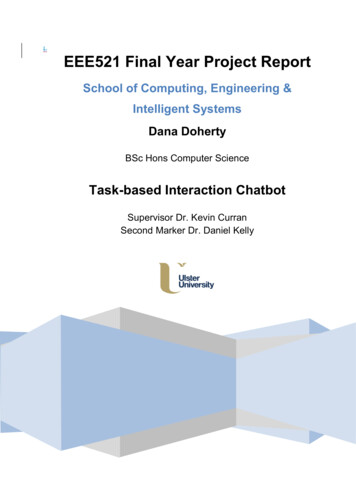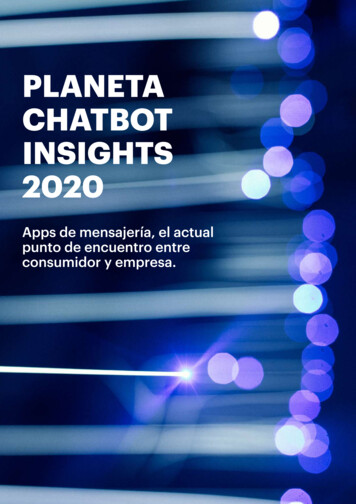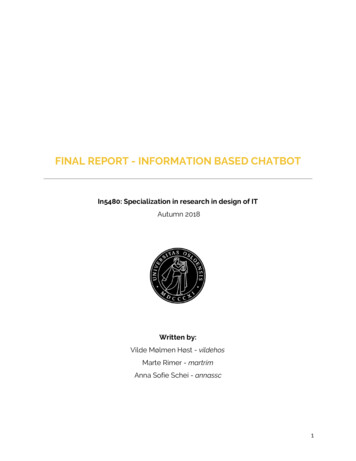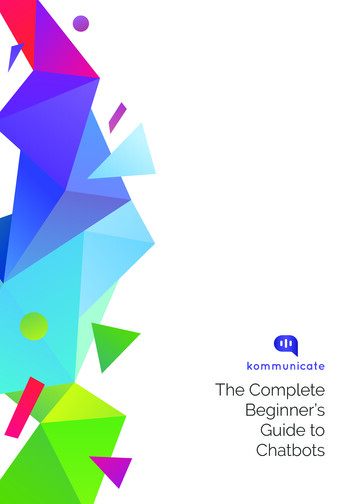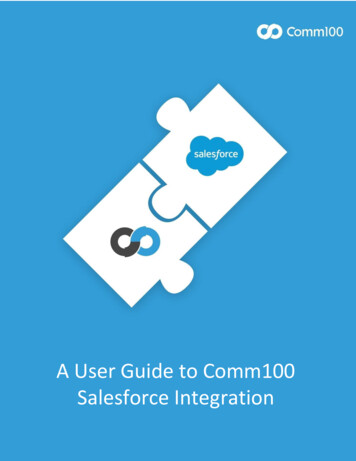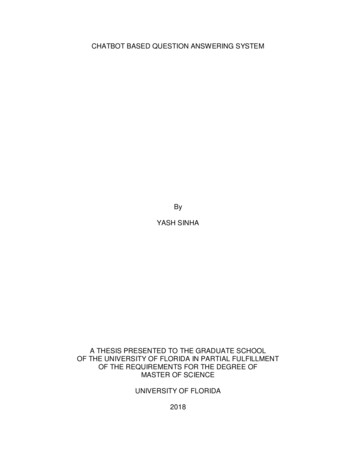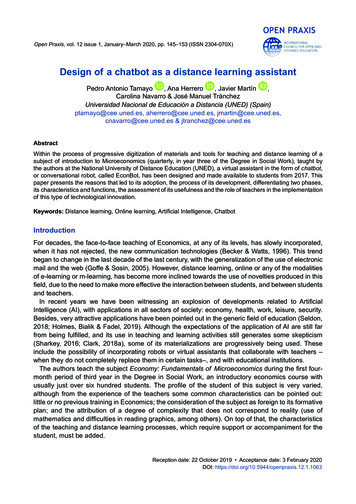
Transcription
Open Praxis, vol. 12 issue 1, January–March 2020, pp. 145–153 (ISSN 2304-070X)Design of a chatbot as a distance learning assistantPedro Antonio Tamayo, Ana Herrero, Javier Martín,Carolina Navarro & José Manuel TránchezUniversidad Nacional de Educación a Distancia (UNED) (Spain)ptamayo@cee.uned.es, aherrero@cee.uned.es, jmartin@cee.uned.es,cnavarro@cee.uned.es & jtranchez@cee.uned.esAbstractWithin the process of progressive digitization of materials and tools for teaching and distance learning of asubject of introduction to Microeconomics (quarterly, in year three of the Degree in Social Work), taught bythe authors at the National University of Distance Education (UNED), a virtual assistant in the form of chatbot,or conversational robot, called EconBot, has been designed and made available to students from 2017. Thispaper presents the reasons that led to its adoption, the process of its development, differentiating two phases,its characteristics and functions, the assessment of its usefulness and the role of teachers in the implementationof this type of technological innovation.Keywords: Distance learning, Online learning, Artificial Intelligence, ChatbotIntroductionFor decades, the face-to-face teaching of Economics, at any of its levels, has slowly incorporated,when it has not rejected, the new communication technologies (Becker & Watts, 1996). This trendbegan to change in the last decade of the last century, with the generalization of the use of electronicmail and the web (Goffe & Sosin, 2005). However, distance learning, online or any of the modalitiesof e-learning or m-learning, has become more inclined towards the use of novelties produced in thisfield, due to the need to make more effective the interaction between students, and between studentsand teachers.In recent years we have been witnessing an explosion of developments related to ArtificialIntelligence (AI), with applications in all sectors of society: economy, health, work, leisure, security.Besides, very attractive applications have been pointed out in the generic field of education (Seldon,2018; Holmes, Bialik & Fadel, 2019). Although the expectations of the application of AI are still farfrom being fulfilled, and its use in teaching and learning activities still generates some skepticism(Sharkey, 2016; Clark, 2018a), some of its materializations are progressively being used. Theseinclude the possibility of incorporating robots or virtual assistants that collaborate with teachers –when they do not completely replace them in certain tasks–, and with educational institutions.The authors teach the subject Economy: Fundamentals of Microeconomics during the first fourmonth period of third year in the Degree in Social Work, an introductory economics course withusually just over six hundred students. The profile of the student of this subject is very varied,although from the experience of the teachers some common characteristics can be pointed out:little or no previous training in Economics; the consideration of the subject as foreign to its formativeplan; and the attribution of a degree of complexity that does not correspond to reality (use ofmathematics and difficulties in reading graphics, among others). On top of that, the characteristicsof the teaching and distance learning processes, which require support or accompaniment for thestudent, must be added.Reception date: 22 October 2019 Acceptance date: 3 February 2020DOI: https://doi.org/10.5944/openpraxis.12.1.1063
146Pedro Antonio Tamayo et al.To this end, and as part of the process of generating support materials, preferably in digitalformat, developed by the authors, the creation of a new tool based on AI was tackled in 2017, on anexperimental basis, which would serve to increase existing communication and support options: achatbot called EconBot1.What a chatbot is and how it can be used in educationA chatbot or conversational robot is a computer program capable of interacting with people usingnatural language. Its main function is to simulate a coherent human conversation –Garcia Brustenga,Fuertes-Alpiste & Molas-Castells (2018), expose in detail what chatbots are, and their modalities,along with some experiences of use in education.Although the first designs of conversational robots date back to the seventies of the past century,the closest antecedents in the use of this type of assistants as learning support elements arefound in the early years of this century. It is in recent years, with new developments in IA (Heller,Procter, Mac, Jewell, Lisa & Cheung, 2005), with chatbots such as Ada, and Freudbot, (the last oneaccessible from .html), when they have becomepresent in everyday environments with virtual assistants deployed by Apple, Google, Facebook, orMicrosoft (Holmes et al., 2019). In this context, Singh (2018) and Clark (2018b) have noted verycomprehensively the roles that conversational assistants can play in teaching/learning processes: Intelligent tutoring systems: a function already available in the eighties of the past century, andwhich can now be enriched with the possibility of customizing learning environments for eachstudent, based on the analysis of their responses and their browsing trail through the digitizedcontent. Improve student participation: the aim is to take advantage of the tendency to use instant messaging systems through a chatbot that acts as a communication platform. Intelligent feedback: on the design of the course, the subject, the operation of tutorials, and oninformation that once collected by the chatbot is sent to the teacher or the institution foranalysis. Teaching assistants: a chatbot can assist the teacher in performing the most repetitive tasks,follow the student’s progress, or provide personalized feedback. Immediate help for the student: it allows to automate and provide in an immediate way habitualanswers, both of administrative character and related to the contents of the subject. Alternative to Learning Management Systems (LMS): chatbot can perform functions traditionally integrated into LMS more dynamically, by providing access to materials in different formats,external links, doubt sections, messaging, etc. Mentoring functions: not only providing the students with information, but also guiding them inthe search for it, for example through problem solving. Skills practice: the chatbot can assume the role of patient, consumer, client, or citizen withwhom students can practice the skills and techniques they have learnt in the subject.Reasons to design EconBotThe context that explains the decision to design and implement a conversational robot in theteaching and learning of an introductory subject to Economics, was determined by four simultaneouscircumstances: the previous work of the teaching team providing students educational technologies1To use EconBot you need to have a Facebook account. EconBot can be accessed from its Facebook page https://www.facebook.com/econbotUNED/ There you can scan the code on the cover with the Messenger application for mobile, or startchatting with the chatbot from the chat option included on the same page.Open Praxis, vol. 12 issue 1, January–March 2020, pp. 145–153
Design of a chatbot as a distance learning assistant147that link them more actively in their learning process; the persistence in the National University ofDistance Education (UNED) of recovery exams in September (extraordinary call, in the terminology ofthe University), without attention to the student during the month of August; the observed prevalenceof the use of mobile instant messaging applications by students, to the detriment of those availablewithin LMS; and the emergence and popularization of new options for the design and implementationof chatbots, fundamentally from 2016.September exams are still being heldThe UNED maintains the realization of recovery tests in the month of September of each academicyear. During the period between the end of the teaching activity –which includes attention to thestudent through the communication tools of the LMS implanted in the UNED–, and the implementationof those tests, there is no scheme of attention to the student. During August, the time students spendpreparing the recovery tests, faculty are no longer available to solve their doubts, or to support andreinforce their learning. This is the longest period of time in which there is no type of relationship withthe teaching team of the subject.Prevalence of the use of instant messaging applicationsThe decision to experiment with the design of a virtual assistant was reinforced by the authors’experience of the new communication habits observed in the students. In most recent academic years,the progressive abandonment of the communication tools that form part of the LMS –fundamentallythe forums of doubts and discussion boards– has been verified. Simultaneously, students are showingan increasing use of instant messaging applications available for smartphones, mainly WhatsApp,Telegram and Messenger, to create study or support groups for each subject.This consideration from the experience of the authors is consistent with available data on mobiledevice usage. According to the report Digital Society in Spain 2017 (Fundación Telefónica, 2018),86% of young people have a mobile device with network access (smartphone), and use it for: instantmessaging (81.7%), access to social networks (77.5%), music consumption (65.2%), and streamingvideo consumption (52.2%). The forecast is that 50% of young people will be mobile first, i.e. between90% and 100% of their network consumption will take place on a mobile screen.This pattern of use of messaging applications is not exclusive to the youngest, a profile that is notthe majority in the UNED. According to the same report, in the 30-39 age group, the use to sendand receive messages instantly amounts 80.6%. For users between the ages of 40 and 55, thisapplication accounts for 73.3% of their use.This trend has continued in the last year, according to the report Digital Society in Spain 2018(Fundación Telefónica, 2019): instant messaging represented 94.3% of the use of smart mobile phones.Technical possibilities for the development of a chatbotIn 2016, chatbots or conversational robots broke in, largely driven by Facebook’s decision to allowthe incorporation of such functionality into its Messenger messaging platform. From that momenton, specific commercial applications and platforms began to be developed in order to design andimplement chatbots, both for the main instant messaging applications and for websites.Although their initial capacities were directed towards commerce, their possibilities for other environmentssuch as education were soon discovered, especially within programs that are taught in the form ofe-learning. That same year, Ashok Goel, a professor at the Georgia Institute of Technology, reported thatOpen Praxis, vol. 12 issue 1, January–March 2020, pp. 145–153
148Pedro Antonio Tamayo et al.he had been using a chatbot based on IBM’s Watson tool (Goel et al., 2016) as an assistant in his courseon artificial intelligence without students perceiving that it was not human (TEDx Talks, 2016).Design and use of EconBotThe process of creating the chatbot and putting it into operation has gone through two stages which,although cumulative in nature, differ in terms of the objectives pursued and the type of contentprovided in each of them. The first one, in which it was decided to experiment with this type ofinteraction tools, had the main objective of accompanying the student in the preparation of the examof the subject in the call of September 2017. At this stage, the secondary objective was to begin aprocess of reviewing the contents of the course, as well as evaluating the materials used for teaching,an objective that was postponed until the next academic year.The second stage, which is still in process, began in 2018. Now it is a question of not only having away of interacting with students during the time in which the other ways cease to be used, but also ofhaving a virtual and permanent assistant of the subject. After evaluating the use of chatbot in August2017, and presenting it in some internal seminars dedicated to innovation in educational technology,work continues to be done in order to complete and enrich the knowledge module dedicated to thebasic contents of the subject.First stage: EconBot to support the preparation of “catch-up” examsThe chatbot design options were largely limited by the technical capabilities and skills of the teachingteam, with little experience in the programming languages usually used to create bots, and nonein the Natural Language Processing on which these tools are based. For these reasons, it wasdecided to use some of the existing commercial applications for the creation and deployment ofconversational robots. After reviewing the options available, and analyzing the degree of difficulty foramateur users, the free option of a commercial platform was chosen.It was at this stage when the different support options that the chatbot should have in order to helpstudents were decided. Thus, the content that was provided to the chatbot in the first stage was thefollowing: Trivial conversation module (small talk): the chatbot was provided with a minimum content thatwould allow it to maintain a basic level of occasional or trivial conversation, such as greeting,responding to the greeting, saying goodbye, and recognizing its lack of knowledge, among otherpossibilities. It is in this module that the personality of the bot is most clearly constructed. Subscription form to the notifications planned for August 2017: in his first conversation with thechatbot, and permanently in its main menu, the student could subscribe through a simple menuof two options (accept the subscription, or leave it for later), to receive messages of support andreview the content of the subject scheduled for the month of August. In turn, the student couldcancel such a subscription at any time, through the main chatbot menu. Support and review content for the month of August 2017: through the programming optionsavailable on the platform used, review messages to be sent to previously subscribed studentswere prepared in different formats (multiple choice exercises, see Figure 1; reminder of theimportance of some concepts and relationships, see Figure 2; messages of encouragement tothe student), as well as messages with explanatory content to be received by students who didnot respond correctly to the proposed exercises. Links to digital content of the subject: the student was offered a menu of options, limited by thepossibilities of the platform used, with links to digital format learning tools existing in the subject that, in the opinion of the teaching team, could be particularly useful in that period of study.Open Praxis, vol. 12 issue 1, January–March 2020, pp. 145–153
Design of a chatbot as a distance learning assistant149More specifically, it was linked to the Course available in iTunes, to the subject’s webapp, andto the dedicated channel on YouTube.In EconBot’s design, and especially regarding its personality expressed through the answers providedfor the terms integrated in its conversational modules, one of the principles of multimedia designproposed by Mayer (2009; 2014) has been applied, suggesting the use of an informal and friendlytone, without falling into exaggeration. For example, the user is addressed by the name under whichshe participates in Facebook.The availability of the chatbot, and the way to access it, was communicated to the students bymeans of an email message. It informed them of what EconBot was, how it would be used duringAugust 2017, and the functionalities it had at that time. Basically, they were explained that those whosubscribed would receive periodic notifications prepared by the teaching team specifically to guidetheir study during that month, and would also receive support during that time.From August 2th, the day on which the first message was sent, until the last message was senton September 11th, coinciding with the end of the extraordinary period of examinations, twenty-fourmessages were sent at an approximate interval of one every two days (Figure 3). Besides, studentsreceived a final message after the subject exam had already been taken in September, in which theywere informed on the availability of the most correct answers for the different examination models used.When the content of the message was a multiple choice question, a second explanatory messageabout the most correct answer was sent to students who had incorrectly answered the former one.Figure 1: Image of the message sent by EconBot with graphic to review,and multiple selection exercise (in Spanish).Open Praxis, vol. 12 issue 1, January–March 2020, pp. 145–153
150Pedro Antonio Tamayo et al.Figure 2: Image of the first message sent by EconBot with a reminder of important concepts andrelationships of the first topic of the course (in Spanish).Figure 3: Daily message readings: August 2 - September 11, 2017.Open Praxis, vol. 12 issue 1, January–March 2020, pp. 145–153
Design of a chatbot as a distance learning assistant151The chatbot offer was well received by the students, but the impossibility of connecting it to theLMS used by the University did not provide us with usage data. They also did not use in EconBotthe same identifier they use as students at the University. This disconnection made it impossible toapproach learning analytics, such as those regarding the use of chatbot with the score obtained inthe September exams.Second stage: EconBot as a permanent virtual assistantOnce the initial objective of this digitization project had been achieved, it was decided to incorporateit into the virtual course as a permanent virtual assistant, although still under an experimental mode.Now EconBot has been enriched by expanding its content on: Administrative knowledge: specific modules were built with content on administrative issues,and the operation of the subject: ways to contact the teaching team, office hours, exam dates,ways to file complaints about grades, etc. The aim was to progressively replicate part of thenon-teaching content collected on the University’s website for the subject, so as to facilitate itssearch by locating it into a mobile tool such as chatbot. Basic concepts of Microeconomics: at this point, we have chosen to use different formats for thepresentation of the contents, once the concepts to be included from the experience of theteachers have been selected. On the one hand, there are links to other materials already available, such as those already collected in the webapp of the subject. And on the other hand,specific responses are built, in text or chatbot response message format. In order to increasethe effectiveness of the presentation of some concepts (Vazquez & Chiang, 2014) consideredof special relevance as learning objectives by the teaching team, it was decided to enrich thevisual content of the chatbot with the elaboration of specific images, and short videos in variousformats (mp4, GIF). They were especially adapted to the format of the messaging application,and to the evidence available on the use of mobile devices.EconBot Usage assessmentThe design and implementation of the chatbot has served to enrich the teaching and learningenvironment of the subject, by providing students with a new communication tool adapted to theirnew habits, based on the use of mobile messaging applications. The experience of its use hasproved the great potential that IA-based tools offer for teaching, and more specifically to assist andsupport the student in autonomous learning modalities, such as that of the University in which theauthors develop their activity. The usefulness of conversational bots has been proven to make up forthe absence of student care functions in periods such as vacations, as it happens during the monthof August, as long as the extraordinary examinations are maintained in the month of September.This initiative has also acted as a lever to promote the revision of the content of the subject, byhaving to select the most relevant economic concepts and relationships for inclusion in the contentmodule. Thus, it has forced to adjust the expression of the teaching activity to the requirements of theuse of mobile applications, simplifying the explanations. It has also led to an assessment of the needto generate a conceptual map of ideas the teaching and learning of which can be understood as basicin an introductory course to Economics in non-economic Grades. And it has shown the convenienceof extending the module of contents with those corresponding to the continuation subject of the onereferred to here, Economy: Macroeconomic Fundamentals.On the other hand, it has been proven that the development of this type of tools by instructorswithout previous experience or training, opens the door to risks inherent to amateur dedication inOpen Praxis, vol. 12 issue 1, January–March 2020, pp. 145–153
152Pedro Antonio Tamayo et al.terms of design. And has, in any case, a high opportunity cost in terms of the tasks of universityprofessors.In addition, having to use a commercial application means introducing serious limitations to theproject. Although it has served the basic purposes pursued, its commercial nature makes the finalproduct dependent on the changes introduced in the application in terms of data traffic allowed by thecompany owner, available features, number of users that can be reached, etc.Together with the above, the use of applications such as the one chosen, disconnected from theLMS of the subject, hinders the availability of usage data that allow an elemental approach from theanalytical learning.Chatbots models such as EconBot have, by their own design, shortcomings that need to beovercome. For example, it does not allow students to customize their learning beyond the feedbackpossibilities shown. Nor does it allow us to offer contextualized answers. Limitations that could beresolved with a specific programming from the beginning, carried out by professionals. It seemsnecessary to have a department dedicated to technological development, working together withfaculty, specialized in the design and implementation of this type of tools. It would also be necessaryto look for programming languages that facilitate a design without the limitations of commercialapplications, and to have support to extract valuable information on patterns of use and learning.ReferencesBecker, W.E., & Watts, M. (1996). Chalk and talk: A national survey on teaching undergraduate economics. American Economic Review, 86(2), 448–453.Clark, D. (2018a, April 10). The Fallacy of ‘Robot’ Teachers [Blog post]. Retrieved from allacy-of-robot-teachers.htmlClark, D. (2018b, December 17). 10 uses for Chatbots in learning (with examples) [Blog post].Retrieved from es-for-chatbots-in-learningwith.htmlFundación Telefónica (2018). Sociedad Digital en España 2017 [Digital Society in Spain 2017].Madrid: Ariel.Fundación Telefónica (2019). Sociedad Digital en España 2018 [Digital Society in Spain 2018].Madrid: Ariel.Garcia Brustenga, G., Fuertes-Alpiste, M., Molas-Castells, N. (2018). Briefing paper: chatbots ineducation. Barcelona: eLearn Center. Universitat Oberta de Catalunya.Goel, A., Anderson, T., Belknap, J.; Creeden, B.; Hancock, W.; Kumble, M.; Salunke, S.; Sheneman,B.; Shetty, A. & Wilden, B. (2016). Using Watson for Constructing Cognitive Assistants. Advancesin Cognitive Systems, 4, 1–16.Goffe, W.L., & Sosin, K. (2005). Teaching with technology: May you live in interesting times. Journalof Economic Education, 36(3), 278–291. https://doi.org/10.3200/JECE.36.3.278-291Heller, B., Procter, M., Mac, D., Jewell, L., & Cheung, B. (2005). Freudbot: An investigation of chatbots technology in distance education. Retrieved from https://psych.athabascau.ca/html/ pdfHolmes, W., Bialik, M., & Fadel, C. (2019). Artificial Intelligence in Education. Boston: Center forCurriculum Redesign.Mayer, R.E. (2009). Multimedia Learning (2nd ed.). Cambridge University Press, Kindle edition.Mayer, R.E. (2014). Learning and Instruction (2nd ed.). Madrid: Alianza Editorial, Kindle edition.Seldon, A. (2018). The Fourth Education Revolution: Will Artificial Intelligence Liberate or InfantiliseHumanity. Buckingham: University of Buckingham Press.Sharkey, A.J.C. (2016). Should we welcome robot teachers? Ethics and Information Technology,18(4), 283–297. https://doi.org/10.1007/s10676-016-9387-zOpen Praxis, vol. 12 issue 1, January–March 2020, pp. 145–153
Design of a chatbot as a distance learning assistant153Singh, R. (2018, May 2). AI and Chatbots in Education: What Does The FutureHold? [Blog post]Retrieved from ucation-what-does-thefuturehold-9772f5c13960TEDx Talks (2016, November 1). A teaching assistant named Jill Watson [Video file]. Retrieved fromhttps://youtu.be/WbCguICyfTAVazquez, J.J., & Chiang, E.P. (2014). A picture is worth a thousand words (at least): The effective useof visuals in the economics classroom. International Review of Economics Education, 17, 109–119. https://doi.org/10.1016/j.iree.2014.08.006Papers are licensed under a Creative Commons Attribution 4.0 International LicenseOpen Praxis, vol. 12 issue 1, January–March 2020, pp. 145–153
such as education were soon discovered, especially within programs that are taught in the form of . e-learning. That same year, Ashok Goel, a professor at the Georgia Institute of Technology, reported that . he had been using a . chatbot. based on IBM's Watson tool (Goel et al., 2016) as an assistant in his course on artificial intelligence .
